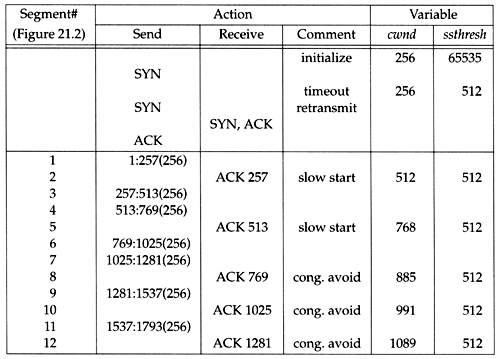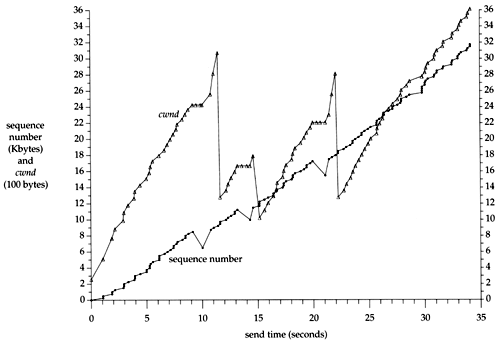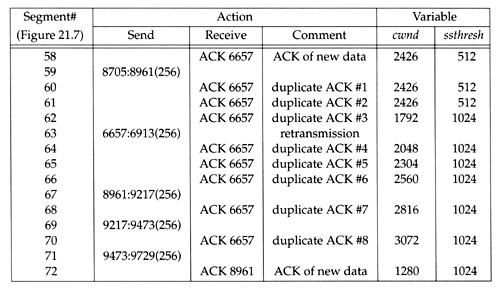21.8 Congestion Example (Continued)
21.8 Congestion Example ( Continued )
Watching a connection using tcpdump and the socket debug option (which we described in Section 21.4) we can see the values of cwnd and ssthresh as each segment is transmitted. If the MSS is 256 bytes, the initial values of cwnd and ssthresh are 256 and 65535, respectively. Each time an ACK is received we can see cwnd incremented by the MSS, taking on the values 512, 768, 1024, 1280, and so on. Assuming congestion doesn't occur, eventually the congestion window will exceed the receiver's advertised window, meaning the advertised window will limit the data flow.
A more interesting example is to see what happens when congestion occurs. We'll use the same example from Section 21.4. There were four occurrences of congestion while this example was being run. There was a timeout on the transmission of the initial SYN to establish the connection (Figure 21.5), followed by three lost packets during the data transfer (Figure 21.6).
Figure 21.9 shows the values of the two variables cwnd and ssthresh when the initial SYN is retransmitted, followed by the first seven data segments. (We showed the exchange of the initial data segments and their ACKs in Figure 21.2.) We show the data bytes transmitted using the tcpdump notation: 1:257(256) means bytes 1 through 256.
Figure 21.9. Example of congestion avoidance .

When the timeout of the SYN occurs, ssthresh is set to its minimum value (512 bytes, which is two segments for this example). cwnd is set to one segment (256 bytes, which it was already at) to enter the slow start phase.
When the SYN and ACK are received, nothing happens to the two variables, since new data is not being acknowledged .
When the ACK 257 arrives, we are still in slow start since cwnd is less than or equal to ssthresh, so cwnd in incremented by 256. The same thing happens when the ACK 513 arrives.
When the ACK 769 arrives we are no longer in slow start, but enter congestion avoidance. The new value for cwnd is calculated as

This is the 1/ cwnd increase that we mentioned earlier, taking into account that cwnd is really maintained in bytes and not segments. For this example we calculate

which equals 885 (using integer arithmetic). When the next ACK 1025 arrives we calculate

which equals 991. (In these expressions we include the incorrect 256/8 term to match the values calculated by the implementation, as we noted on p. 311.)
This additive increase in cwnd continues until the first retransmission, around the 10-second mark in Figure 21.6. Figure 21.10 is a plot of the same data as in Figure 21.6, with the value of cwnd added.
Figure 21.10. Value of cwnd and send sequence number while data is being transmitted.

The first six values for cwnd in this figure are the values we calculated for Figure 21.9. It is impossible in this figure to tell the difference visually between the exponential increase during slow start and the additive increase during congestion avoidance, because the slow start phase is so quick.
We need to explain what is happening at the three points where a retransmission occurs. Recall that each of the retransmissions took place because three duplicate ACKs were received, indicating a packet had been lost. This is the fast retransmit algorithm from Section 21.7. ssthresh is immediately set to one-half the window size that was in effect when the retransmission took place, but cwnd is allowed to keep increasing while the duplicate ACKs are received, since each duplicate ACK means that a segment has left the network (the receiving TCP has buffered it, waiting for the missing hole in the data to arrive ). This is the fast recovery algorithm.
Figure 21.11 is similar to Figure 21.9, showing the values of cwnd and ssthresh. The segment numbers in the first column correspond to Figure 21.7.
Figure 21.11. Example of congestion avoidance (continued).

The values for cwnd have been increasing continually, from the final value in Figure 21.9 for segment 12 (1089), to the first value in Figure 21.11 for segment 58 (2426). The value of ssthresh has remained the same (512), since there have been no retransmissions in this period.
When the first two duplicate ACKs arrive (segments 60 and 61) they are counted, and cwnd is left alone. (This is the flat portion of Figure 21.10 preceding the retransmission.) When the third one arrives, however, ssthresh is set to one-half cwnd (rounded down to the next multiple of the segment size). cwnd is set to ssthresh plus the number of duplicate ACKs times the segment size (i.e., 1024 plus 3 times 256). The retransmission is then sent.
Five more duplicate ACKs arrive (segments 64 “66, 68, and 70) and cwnd is incremented by the segment size each time. Finally a new ACK arrives (segment 72) and cwnd is set to ssthresh (1024) and the normal congestion avoidance takes over. Since cwnd is less than or equal to ssthresh (they are equal), the segment size is added to cwnd, giving a value of 1280. When the next new ACK is received (which isn't shown in Figure 21.11), cwnd is greater than ssthresh, so cwnd is set to 1363.
During the fast retransmit and fast recovery phase, we transmit new data after receiving the duplicate ACKs in segments 66, 68, and 70, but not after receiving the duplicate ACKs in segments 64 and 65. The reason is the value of cwnd, versus the number of unacknowledged bytes of data. When segment 64 is received, cwnd equals 2048, but we have 2304 unacknowledged bytes (nine segments: 46, 48, 50, 52, 54, 55, 57, 59, and 63). We can't send anything. When segment 65 arrives, cwnd equals 2304, so we still can't send anything. But when segment 66 arrives, cwnd equals 2560, so we can send a new data segment. Similarly when segment 68 arrives, cwnd equals 2816, which is greater than the 2560 bytes of unacknowledged data, so we can send another new data segment. The same scenario happens when segment 70 is received.
When the next retransmission takes place at time 14.3 in Figure 21.10, it is also triggered by the reception of three duplicate ACKs, so we see the same increase in cwnd as one more duplicate ACK arrives, followed by a decrease to 1024.
The retransmission at time 21.1 in Figure 21.10 is also triggered by duplicate ACKs. We receive three more duplicates after the retransmission, so we see three additional increases in cwnd, followed by a decrease to 1280. For the remainder of the transfer cwnd increases linearly to a final value of 3615.
EAN: 2147483647
Pages: 378
- Enterprise Application Integration: New Solutions for a Solved Problem or a Challenging Research Field?
- The Effects of an Enterprise Resource Planning System (ERP) Implementation on Job Characteristics – A Study using the Hackman and Oldham Job Characteristics Model
- Intrinsic and Contextual Data Quality: The Effect of Media and Personal Involvement
- A Hybrid Clustering Technique to Improve Patient Data Quality
- Relevance and Micro-Relevance for the Professional as Determinants of IT-Diffusion and IT-Use in Healthcare